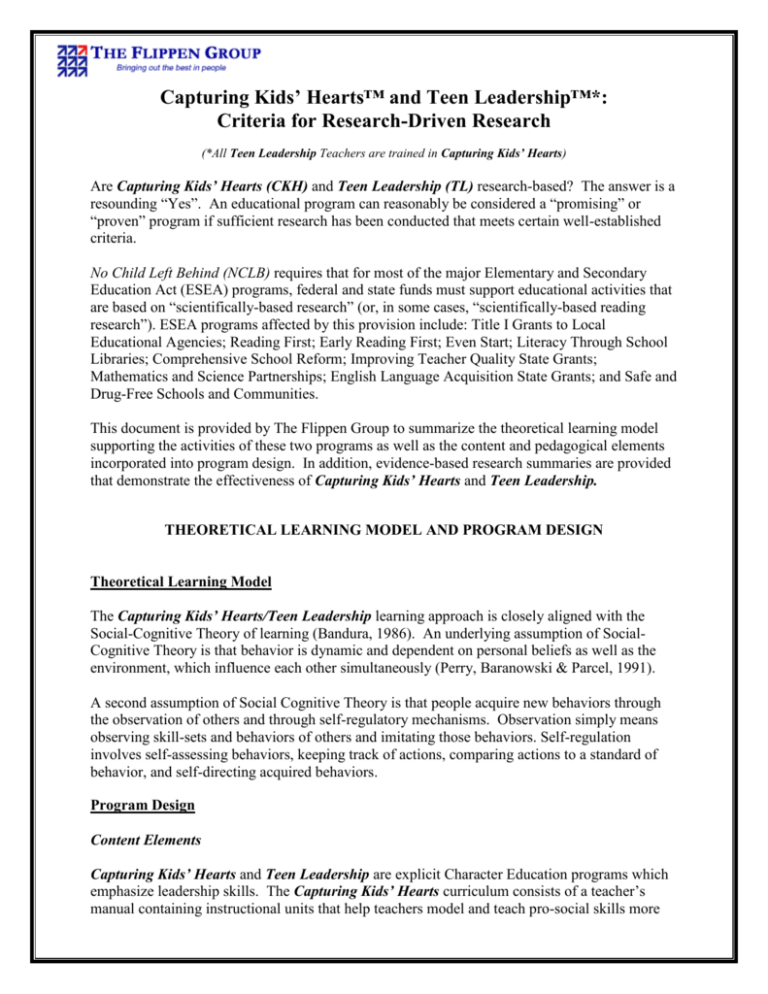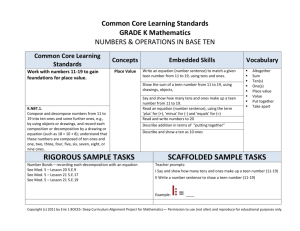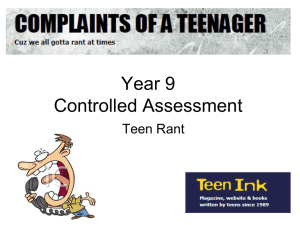Word - The Flippen Group
advertisement

Capturing Kids’ Hearts™ and Teen Leadership™*: Criteria for Research-Driven Research (*All Teen Leadership Teachers are trained in Capturing Kids’ Hearts) Are Capturing Kids’ Hearts (CKH) and Teen Leadership (TL) research-based? The answer is a resounding “Yes”. An educational program can reasonably be considered a “promising” or “proven” program if sufficient research has been conducted that meets certain well-established criteria. No Child Left Behind (NCLB) requires that for most of the major Elementary and Secondary Education Act (ESEA) programs, federal and state funds must support educational activities that are based on “scientifically-based research” (or, in some cases, “scientifically-based reading research”). ESEA programs affected by this provision include: Title I Grants to Local Educational Agencies; Reading First; Early Reading First; Even Start; Literacy Through School Libraries; Comprehensive School Reform; Improving Teacher Quality State Grants; Mathematics and Science Partnerships; English Language Acquisition State Grants; and Safe and Drug-Free Schools and Communities. This document is provided by The Flippen Group to summarize the theoretical learning model supporting the activities of these two programs as well as the content and pedagogical elements incorporated into program design. In addition, evidence-based research summaries are provided that demonstrate the effectiveness of Capturing Kids’ Hearts and Teen Leadership. THEORETICAL LEARNING MODEL AND PROGRAM DESIGN Theoretical Learning Model The Capturing Kids’ Hearts/Teen Leadership learning approach is closely aligned with the Social-Cognitive Theory of learning (Bandura, 1986). An underlying assumption of SocialCognitive Theory is that behavior is dynamic and dependent on personal beliefs as well as the environment, which influence each other simultaneously (Perry, Baranowski & Parcel, 1991). A second assumption of Social Cognitive Theory is that people acquire new behaviors through the observation of others and through self-regulatory mechanisms. Observation simply means observing skill-sets and behaviors of others and imitating those behaviors. Self-regulation involves self-assessing behaviors, keeping track of actions, comparing actions to a standard of behavior, and self-directing acquired behaviors. Program Design Content Elements Capturing Kids’ Hearts and Teen Leadership are explicit Character Education programs which emphasize leadership skills. The Capturing Kids’ Hearts curriculum consists of a teacher’s manual containing instructional units that help teachers model and teach pro-social skills more 2 effectively. The Teen Leadership curriculum consists of a teacher’s manual as well as a student workbook that re-enforces leadership and pro-social skills. Mastery of leadership and pro-social skills is integrated into the academic curriculum. Therefore, the following content elements are present in Capturing Kids’ Hearts and Teen Leadership: Explicit Character Education and Leadership Instruction Social and Emotional Curriculum Academic Curriculum Integration Pedagogical Elements Capturing Kids’ Hearts and Teen Leadership incorporate the following pedagogical elements that are considered to be part of effective teaching strategies (Berkowitz & Bier, 2005): Direct Teaching Interactive Teaching/Learning Classroom/Behavior Management Modeling/Mentoring Professional Development Each aspect of the Capturing Kids’ Hearts training is modeled by highly-trained, skilled facilitators. Not only do the participants observe the desired skill-sets from the facilitator, but they also practice these skills by participating in the training’s interactive and experiential activities. Consequently, the participants have confidence that they can model the desired relational skills and implement classroom management skills successfully. 3 SUMMARY OF RESEARCH AND EXTERNAL RECOGNITION OF EFFECTIVENESS “Scientifically-based” research, also referred to as “evidence-driven”, “evidence-based”, or “empirical” research, is defined in the NCLB Act as including experimental or quasiexperimental studies, with a preference for randomized controlled trials. The document entitled A Report to the Nation…Smart & Good High Schools: Integrating Excellence and Ethics for Success in School, Work, and Beyond (Lickona and Davidson, 2005) that was supported by the Character Education Partnership (CEP) and the Center for the 4th and 5th Rs, (SUNY) describes three categories of evidence that program developers should address in order for a program to be considered promising or proven. Program developers should demonstrate: Empirical evidence of effectiveness (experimental, quasi-experimental, and pre/postintervention research designs); Relevance and face validity of outcomes (relevance to important adolescent and school outcomes); and the Testimony of credible sources (external recognition). The manner in which Capturing Kids’ Hearts and Teen Leadership meet the NCLB requirements for evidence-based research as well as the CEP/SUNY criteria for a promising or proven program is addressed in this document. The following information is provided: Empirical evidence of effectiveness—provides evidence-based validation of effectiveness using experimental, quasi-experimental, and case study research designs. The studies highlight school results demonstrating improved academic and behavioral outcomes. Citations of published results for Teen Leadership (with teachers trained in Capturing Kids’ Hearts) in peer-reviewed journals are provided. Supporting studies from researchbased dissertations are included. Relevance and face validity—relates the outcomes of Capturing Kids’ Hearts and Teen Leadership training to important adolescent and school outcomes. Testimony of credible sources—highlights state and federal recognition of the programs on approved or promising program lists, in addition to state and national awards of the schools who give testimony to the impact of Capturing Kids’ Hearts and Teen Leadership. In addition to the three criteria listed above, The Flippen Group continues to conduct evidence-based research studies: On-going research—initiated to provide further evidence of the effectiveness of our programs. For the full research reports of each of the summaries provided in this publication, please go to http://www.flippengroup.com/education/edursrch.html. 4 Empirical Evidence of Effectiveness: Research Validation Experimental, Quasi-Experimental, & Case Study Research Designs (Supporting Research from Doctoral Dissertations and In-house Research Studies) QUASI-EXPERIMENTAL RESEARCH (2 Studies Published) STUDIES 1 & 2 Citation: Cirillo-Teverbaugh, K.J. & Colwell, B. (1993). Effects of a 10-week socialcognitive group intervention on selected psychosocial attributes and interpersonal effectiveness of high school students. Unpublished manuscript, Texas A&M University, College Station, TX. Citation: Cirillo-Teverbaugh, K.J. (1994). Adolescent loneliness: Implications and intervention strategies. Eta Sigma Gamma Student Monograph Series. Research Design: Quasi-Experimental (Non-randomized) Controlled Trial Ph.D. Dissertation Research: No Research Published in a Peer-Reviewed Journal: Yes Summary of Research Texas A&M University, 1993, 1994: Researchers explored the effects of Capturing Kids’ Hearts and Teen Leadership on self-esteem, loneliness, parent-adolescent communication and perception of leadership development of high school students from a city in east-central Texas. The research study used a randomized controlled trial research study design to investigate the effects of Capturing Kids’ Hearts and Teen Leadership. Thirty-six experimental group members participated in the social-cognitive intervention. Thirtyfour students in a youth organization from the same city served as the control group and did not receive the intervention. The experimental group met once a week for ten consecutive weeks. Each session was two hours in duration. The experimental and control groups were asked to fill out a questionnaire prior to and upon completion of the intervention. Significant interactions were investigated with simple main-effects analyses. Instrument Range, Pre and Post-test Means and Standard Errors for Dependent Variables for the Control and Experimental Groups Variables Pretest Mean Standard Error Post-Test Mean Standard Error Self-Esteem Range (0-64) * Experimental Control Attitude Toward 40.33 40.53 1.11 2.11 46.91 39.50 1.01 1.21 5 Group Work Range (25-175) * Experimental Control Personal Development Range (24 -168) 124.39 119.85 1.34 2.11 132.97 118.02 1.65 2.12 * Experimental Control Loneliness Range (20 – 80) 136.36 127.91 1.86 3.08 147.25 127.38 1.77 3.13 * Experimental Control Mother-Adolescent Communication Range (20 – 100) 37.89 9.94 1.17 1.62 32.50 40.03 1.09 1.53 * Experimental Control Father-Adolescent Communication Range (20 – 100) 62.44 66.23 1.92 1.41 70.63 65.32 1.79 1.31 * 60.75 62.61 2.00 1.50 67.42 63.17 2.07 1.42 Experimental Control Simple main-effects analyses for the intervention group and the control group indicated that for the students receiving the Capturing Kids’ Hearts / Teen Leadership intervention, all measured variables were positively impacted, specifically: Self-esteem/confidence increased Attitude toward group work improved Personal development/maturity improved Loneliness decreased Mother-adolescent communication increased Father-adolescent communication increased These data suggest that using this social-cognitive group intervention, coupled with mentoring from community leaders, holds promise as an intervention for enhancing self-esteem, improving parent-adolescent communication, developing leadership skills and reducing loneliness in high school adolescents. STUDY 3 Citation: Sherwood, R. (2003). It All Began with a Handshake, The Effective Schools Project Journal, 9: 6-11 Research Design: Quasi-Experimental (Non-Randomized) Controlled Trial Ph.D. Dissertation Research: No 6 Research Published in a Peer-Reviewed Journal: Yes Summary of Research Cleburne High School (TX): The results of a study undertaken at Cleburne High School (TX) and published in a peer-reviewed journal highlight the effect of Capturing Kids’ Hearts and Teen Leadership on academic achievement. The comparative, longitudinal study used a quasiexperimental research design with controls. The research demonstrates that academic performance improved when students participated in Teen Leadership. A copy of the published research article may be viewed at the following link: http://www.flippengroup.com/pdf/funding/ESPfinal03.pdf Summary of Effects of Capturing Kids’ Hearts and Teen Leadership: From: The Effective Schools Project Journal, 9:6-11 Cleburne High School Summary of data per student group Total 9th Grade % Passing 1st 6 weeks 2001 English Math Social Studies 64.7 71.4 81.1 Total 9th grade % Passing 1st 6 weeks 2002 76.2 80.7 91.0 *PASS Students % Passing 1st 6 weeks 2002 *Intervention group 95.5 92.6 98.5 Summary: Compared to the general population of students in 9th grade (control group), students in the PASS class (intervention group) in which the teacher had been trained in both Capturing Kids’ Hearts and Teen Leadership demonstrated: 11% lower overall failure rate 19.3% higher English passing rate 11.9% higher mathematics passing rate 7.5% higher social studies passing rate 98% overall attendance rate (2.4% higher than all students.) 7 EXPERIMENTAL RESEARCH (1 Dissertation; 1 Comprehensive Report) STUDY 4 Dissertation: Danaher, A.C. (2006). Character Education: The Impact of a Teen Leadership Program, Texas A&M University, Kingsville. Research Design: Randomized Controlled Trial Ph.D. Dissertation Research: Yes Research Published in a Peer-Reviewed Journal: No Summary of Research Texas A&M University, 2006: Dr. Danaher studied the effect of Teen Leadership on student connectedness. The purpose of the study was to examine the impact of the Teen Leadership program on student perception of school connectedness, student behavior in terms of making smart choices, and student confidence. Her research provided quantitative and qualitative data demonstrating that students who participated in the semester long Teen Leadership class were significantly more connected to their teachers than students in the control group. The Teen Leadership students: Made significantly smarter choices and were therefore better behaved at the end of the semester than students in the control group. Became somewhat more self-confident during the duration of the study. Perceived the class to enhance their feelings of connectivity with each other. Additionally, both teachers and students perceived that the Teen Leadership class heightened the classroom environment and teacher-to-student as well as student-tostudent interactions. The dissertation research is in the process of being published in a peer-reviewed journal. An initial publication (Danaher et al., 2008) containing an overview of character education and the issues facing today’s youth has been published by this author in a peer-reviewed journal. STUDY 5 Citation: Holtzapple, C.K., Griswold, J.S., Cirillo, K.J., Rosebrock, J., Nouza, N., & Berry, C. (2010). Implementation of a school-wide adolescent character education/ prevention program: Evaluating the relationships between principal support, faculty implementation, and student outcomes. Comprehensive report submitted to Oneida-Herkimer-Madison BOCES and Riverside County Office of Education (RCOE). Manuscript in preparation for submission to a peerreviewed journal Research Design: Randomized Controlled Trial Ph.D. Dissertation Research: No 8 Research Published in a Peer-Reviewed Journal: No Submitted to Federal or State Educational Agency: Yes Summary of Research: This study investigated the effect of Capturing Kids’ Hearts-Campus by Design, a comprehensive, school-wide program designed to strengthen students’ connectedness to school through enhancing protective factors (strong bonds with teachers, clear rules of conduct that are consistently enforced) and targeting modifiable risk factors (inappropriate behavior, poor social coping skills). The results demonstrate that the level of support exhibited by school leadership (principal) was linearly related to the level of CKH-CBD implementation by teachers in the classroom, and that the level of implementation (skill modeling) by teachers was linearly related to the level of prosocial skills acquired by students. At 1 school year post-implementation, students’ pro-social skills (respect, caring concern, communicative competencies, citizenship, and problem solving) increased significantly in the intervention schools. The composite score as well as sub-category scores for pro-social outcomes are provided below. Pro-Social Outcomes Student Acquisition of Pro-Social Outcomes Percent Acquisition of Pro-Social Outcomes (Protective Factors) (Control vs. Intervention Schools) 100 Composite Scores for Pro-Social Outcomes Sub-Category Scores for Pro-Social Outcomes PM—Personal Morality • sense of justice/fairness • respect 90 Pr-S—Pro-Social Behaviors • caring concern for others • teamwork • helping others • sharing 80 70 60 CC—Communicative Competencies • communication skills • attentive listening 50 CZ—Citizenship • democratic values 40 PS—Problem Solving • consequential thinking • behavioral adjustment • conflict resolution 30 20 10 0 PreTest PostTest PM Pr-S CC Post-Test CZ PS 9 Discipline referrals decreased in all intervention schools. A standard univariate ANOVA computed the effect size (Hedge’s g) to be -2.1 (significant decrease in discipline referrals in intervention schools compared with control schools). This correlates with a 22% decrease in discipline referrals in the intervention schools and an 11% increase in the control schools. CONTROL SCHOOLS Average INCREASE in referrals 6 4 Change in Discipline Referrals (SD units ) Positive values indicate increases in discipline referrals. The pre-test mean,“0”, represents the mean number of discipline referrals for the previous 3 years. In this case, 2 of the schools experienced increases in discipline referrals and 1 school experienced a decrease in referrals. Change in Discipline Referrals 2 0 Pre-test mean -2 INTERVENTION SCHOOLS Negative values indicate decreases in discipline referrals. All 4 schools experienced decreases in discipline referrals compared to their pre-test mean (derived from the 3 school years prior to initiation of the study). The standardized effect size (Hedge’s g) was computed to be -2.1. Average DECREASE in referrals -4 -6 Control Intervention CASE STUDY RESEARCH (1 study submitted to a state agency) STUDY 6 Ph.D. Dissertation Research: No Published in Peer Reviewed Journal: No Submitted to Federal or State Educational Agency: Yes In March of 2006, The Flippen Group submitted a document to the Texas Education Agency (TEA) that demonstrated the positive effects of Capturing Kids’ Hearts (with or without the addition of Teen Leadership) on academic and behavioral performance—two measures of progress toward college readiness. The data was presented in the form of case studies using a longitudinal pre-treatment/post-treatment study design with delayed acquisition of post-treatment data. The longitudinal studies ranged in length from 2 to 6 years, and at least 3 data collection time points were used for each case study. The studies were submitted primarily to demonstrate the effects of Capturing Kids’ Hearts and Teen Leadership on academic performance; however, some schools also provided behavioral 10 data. This data was included when available. The entire document may be accessed using the following link: http://www.flippengroup.com/pdf/funding/TEA8CaseStudies.pdf Effects of Capturing Kids' Hearts and Teen Leadership Provided to Texas Education Agency for approved program list Summary of Texas School Data: 8 Case Studies Achievement Test Passing Rates, Discipline Referrals, and Dropout Rates Percentile Point Change TEXAS SCHOOLS TAAS Length of All Longitudinal Tests TAAS Study (Yrs.) Taken Reading TAAS Math Change in TAAS Dropout Writing Rate Change in Discipline Referral Rate 1 Brenham JH 2 5.0% 1.9% 5.0% 8.4% * 2 Carroll HS 6 5.4% 1.8% 7.2% 0.2% -0.3% * 3 Cleburne HS 2 1.6% 0.0% 0.9% 0.8% -1.1% * 4 Cypress Falls HS 5 14.6% 3.6% 15.3% 0.8% -0.6% 5 Jersey Village HS 2 3.7% 3.9% 1.3% 0.3% -0.1% * 6 Lomax JH 4 9.1% 6.0% 11.1% -0.5% 0.1% 7 Pasadena HS 6 31.6% 18.6% 32.4% 15.9% -0.8% * 8 South Houston HS 5 28.4% 9.7% 30.8% 8.0% -0.7% * * Data not available TAAS test data were obtained from the Texas Education Agency website. TAAS "Percentile Point Change" indicates changes in passing rates for the standardized achievement test. Information obtained in the years 1996-2002 -70.8% -72.2% The following information contains excerpts from the 8 case studies presented in the full report to TEA: Bondy Intermediate School (Texas): The score for this school went from “Acceptable” to “Exemplary” overall, and the 150 students enrolled in Teen Leadership saw dramatic improvements in their Texas Learning Index scores. The school implemented a comparison study of the students’ grades of the first six weeks after Teen Leadership, with their grades from the previous year. These were at-risk students who had multiple disciplinary reports, police records and detention assignments. The following results were reported. Results Comparing Teen Leadership (TL) Students Test Scores from 1st Six Weeks Enrollment in TL with Previous Year: TLI Index scores Bondy Intermediate School (Texas) Texas Learning Index Scores Overall testing improvement in Teen Leadership students + 74% Overall Teen Leadership students who increased TLI by 10 or more points Overall Teen Leadership students who increased TLI by 15 or more points Overall hispanic males (27 out of 31 of the students) who increased their TLI’s + 24% + 14% + 87% 11 Pasadena High School (Texas): Pasadena High School took part in a longitudinal study to measure the impact of Capturing Kids’ Hearts and Teen Leadership. Over a six year period, the impact of the programs was summarized by administrator Wayne Adams in his statement: “Our school has changed dramatically over the last 6 years of Capturing Kids’ Hearts Training and Teen Leadership.” Results are summarized below. Pasadena High School Outcome Measurement Passing Overall Test Scores Passing Reading Test Scores Passing Writing Scores Prior to CKH Implementation 45% Passing Math Scores Attendance Rates 6 years post CKH Implementation 77% Overall Percent Improvement + 32% 67% 85% + 18% 72% 88% + 16% 55% 88% + 33% 91.5% 94% + 2.5% Lomax Junior High School (Texas): Administrators at Lomax Junior High are crediting CKH with dramatic improvement in tests scores and reduction in infractions. Undertaking a longitudinal study over a 3-year period, the administration reported the following: Lomax Junior High School Outcome Measurement Prior to CKH Implementation Overall Percent Improvement 79.1% 3 years post CKH Implementation 88.2% Passing Overall Test Scores Passing Reading Test Scores 87.8% 93.8% + 6% Passing Math Scores 85% 96.1% + 11% Discipline Referrals 5000 1389 - 72% 74 48 - 39% Suspensions + 9% South Houston High School (Texas): This school undertook an extensive 5-year longitudinal study. After 5 years of implementation and ultimately being credited by the principal who, after 45 years of being in education said this training was by far the most important he had ever implemented. He stated that CKH has changed the culture of the school by helping teachers and kids feel better about themselves, interacting at all levels with one another in a unified manner. The results from the longitudinal study include: South Houston High School Outcome Measurement Prior to CKH Implementation Attendance Rate 91.3% 5 years post CKH Implementation 95.3% Overall Percent Improvement Overall Passing Test Scores 50.5% 78.5% + 28% Passing Math Scores 61.0% 86.2% + 25.2% Passing Reading Scores 74.0% 87.4% + 23.4% Passing Writing Scores 78.6% 90.9% + 12.3% + 2% Data from other schools outside Texas have reported improvements in behavioral and/or academic achievement: 12 South Middle School (Kentucky): The administration undertook a longitudinal study examining the first nine weeks of 2002 compared to the same time frame in 2003. The number of total infractions in disruptive behavior, tardies and dress code violations decreased significantly. The following results were reported: South Middle School Infraction Report Comparison: Discipline Referrals – All 2002 2003 Percent Improvement by Infraction 1719 1110 - 35% Discipline Referrals – Males 1178 694 - 42% Discipline Referrals - Females 541 416 - 23% Tardies Dress Code Violations 526 76 357 12 - 33% - 84% Wayne Community High School (Iowa): After training the entire staff, a longitudinal study was launched to compare academic test scores, discipline referrals, suspensions, and number of students on behavioral plans. The district superintendent reported the following results for the students in the high school: Wayne Community High School Student Population Class of 2003 Class of 2004 Class of 2005 Total School Population Test Scores Increase 11% Increase 8% Increase 8% ------- Discipline Referrals Removal from classrooms: Total number of suspensions ---- ----- ----- ---- ----- ----- ---- ----- ----- 40% Decrease 54% Decrease 52% Decrease * Staff Survey Responses 97% said “yes” to: “I can tell a difference in the atmosphere of my building since CKH training.” 95% said “yes” to: “I believe the entire school has benefited from CKH.” Surprise Lake Middle School (Washington): This school performed a study examining the effectiveness of Teen Leadership after just one semester of intervention. A total of 252 students and 136 parents responded to a survey on their perception of the results of the course. The findings were as follows: 98% of the parents and 96% of the students would recommend Teen Leadership to others. 99% of the parents and 95% of the students considered it a positive experience. 13 99% of the parents and 97% of the students felt the skills learned in Teen Leadership were valuable. 99% of the parents and 98% of the students wanted Teen Leadership offered in the future. Data obtained in the years 2005-2008 from schools throughout the nation continues to demonstrate the positive effects of Capturing Kids’ Hearts with or without Teen Leadership on academic and behavioral performance. Effects of Capturing Kids’ Hearts or Capturing Kids’ Hearts + Teen Leadership: School Discipline & Academic Performance Reports Percentage Increase or Decrease in Activity School Program(s) Implemented Study Duration Discipline Referrals Law Violations Attendance Percentage A,B, Cs Honor Roll (≥3.5 GPA) Forest Park EL (FL) Tomás Rivera MS (CA) Norview HS (CT) (All students) Norview HS (CT) (1st time freshmen) Palm Beach Gardens HS (CA) CKH 1 yr -73.8% CKH 1 yr -27% CKH + TL 3 mo -45.3% -42.9% CKH + TL 3 mo -49.7% -36.4% CKH 1 yr -70.3% +1.8% +16% +17% SUPPORTING RESEARCH FROM DOCTORAL DISSERTATIONS AND IN-HOUSE RESEARCH Dissertation: Cox, T., (2003). A qualitative study of a capacity building professional development experience. West Virginia University (2003): Theodora Cox, Ed.D., performed an extensive study on the impact of Capturing Kids’ Hearts through her research at West Virginia University. She focused on several schools in West Virginia and found that there was a substantial impact on the school environment that was immediate, the full impact of which would not be known for years. Her objective was “to determine: the dynamics of the experience that inspired participants to want to change practices to better facilitate student learning; how selected educators exemplified that inspiration in their daily professional experience; and how the training has impacted classrooms, schools, and school system.” Among the findings were: “Fewer discipline problems.” 14 “Strategies learned in Capturing Kids’ Hearts provide a systematic way of dealing with students as individuals and set the tone for schools and classroom based on mutual respect.” “Students have learned to reach consensus and interact with peers to correct misbehaviors. “The Capturing Kids’ Hearts training has impacted classrooms, schools, and the school system.” “The county high school received a commendation for its nurturing environment from High Schools That Work evaluators.’ Dissertation: Rosebrock, J., (1996). An evaluation of student and teacher perceptions of the Teen Leadership program at Somerville High School. Texas A&M University (1996): Jim Rosebrock, Ed.D., used a quantitative and qualitative approach to study how Capturing Kids’ Hearts and Teen Leadership contribute to schools and their individual members. The research used a naturalistic inquiry process described by Erlandson (et al., 1993) in Doing Naturalistic Inquiry. The research stated, “In keeping with the naturalistic paradigm, the basic methods of instrumentation were campus observation of events, critical incidents, records, documents and interviews using purposive [data collection] over a prolonged engagement with persistent observations and triangulation to promote trustworthiness.” His dissertation results documented statistically significant improvements in school-wide discipline, sense of community, democratic student government, mutual respect, fairness and cooperation, student self-esteem and relationships between staff and staff/student. In-House Research The Flippen Group, 2003: Chris White, Ph.D. explored the effects of Capturing Kids’ Hearts / Teen Leadership in a cross section of 7 different schools, including 500 students. The study design was a longitudinal before/after format, with respondents completing a Likert-type questionnaire at the beginning (January 2002) and at the end (May 2002) of the intervention. The data was gathered by each school and analyzed using a one-tailed pooled two-sample t-test for independent populations. Statistically significant results were found for numerous behavioral and attitudinal factors, including the factors listed below. All of the p-values for the items below are less than 0.05. Statistical results from student responses to: “I am confident in myself.” – INCREASE “I view myself as a leader.” – INCREASE “I make smart decisions and consider the consequences.” – INCREASE “I have goals for myself for college and/or a career.” – INCREASE “I feel like I am connected to and close to my parents/guardians.” – INCREASE “I feel like there are other students who care about me.” – INCREASE “I feel like no one really knows me.” – DECREASE “I am not afraid to speak in front of people.” – INCREASE “I like myself.” – INCREASE “I get in trouble a lot at school.” – DECREASE “I get in trouble a lot outside of school.” – DECREASE “I am comfortable and confident around adults.” INCREASE 15 Relevance and Face Validity: Expected Outcomes Capturing Kids’ Hearts and Teen Leadership Address Important Adolescent/School Outcomes In the document entitled What Works in Character Education: A Research Driven Guide for Educators written by Berkowitz and Bier (2005), and supported by the Character Education Partnership (CEP), the authors provide a taxonomy of relevant outcomes that Character Education programs should address. (see appendices in http://www.character.org/atf/cf/%7BD9ED2C0A-D259-4C2F-8CECAA29F7595F40%7D/practitioners_518.pdf) Below are listed the major categories and sub-categories of adolescent and school outcomes (derived from the appendices from the article by Berkowitz & Bier ) that are addressed by Capturing Kids’ Hearts and Teen Leadership training: Risk Behavior Violence/Aggression 1.5.1. Ridiculing/bullying 1.5.3. Name calling and verbal putdowns General Misbehavior 1.6.4. Rude behavior 1.6.5. Defiance of adult authority Pro-Social Competencies Socio-Moral Cognition 2.1.1. Ethical decision-making ability 2.1.2. Ethical understanding 2.1.3. Understanding multiple perspectives 2.1.4. Moral reasoning Personal Morality 2.2.3. Respect 2.2.4. Honesty 2.2.6. Taking responsibility for one’s actions 2.2.8. Leadership skills 2.2.10. Self-discipline Pro-Social Behaviors & Attitudes 2.3.2. Sense of social responsibility 2.3.4. Getting along with others 2.3.5. Respect and tolerance 2.3.6. Caring & Concern for others 2.3.7. Teamwork and cooperation 2.3.8. Helping others 2.3.9. Including others 2.3.11. Empathy 16 2.3.12. Sharing 2.3.14. Ethical conduct Communicative Competency 2.4.1. Communication skills 2.4.2. Attentive listening Character Knowledge 2.5.1. Understanding of character attributes 2.5.2. Ethical decision-making Relationships 2.6.1. Friends, family 2.6.2. Value intimacy Citizenship 2.7.1. Democratic values School-Based Outcomes School Behavior 3.1.2. Compliance with school rules and expectations 3.1.5. Overall classroom behavior 3.1.6. Participation in classroom activities Attachment to School 3.2.1. Bonding to school 3.2.2. Sense of school as community 3.2.3. Attachment to school 3.2.4. Feeling of belonging to school community 3.2.5. Levels of classroom interest and enthusiasm Attitudes Towards School 3.3.1. Sense of responsibility to school 3.3.2. General school climate is more positive 3.3.3. Adjustment to new school Attitudes Toward Teachers 3.4.1. Trust and respect for teachers 3.4.2. Feelings about whether teachers are trustworthy, supportive, fair and consistent General Social-Emotional Self-Concept 4.1.1. Self-perception 4.1.2. Self-esteem Independence and Initiative 4.2.4. Makes good choices 4.2.5. Self-direction and independence in activities 4.2.9. Acts as a leader in group situations with peers 17 Coping 4.3.4. Self-efficacy Problem Solving Skills 4.4.1. Alternative solutions 4.4.2. Consequential thinking 4.4.3. Behavioral adjustment 4.4.4. Conceptualizing cause-and-effect 4.4.5. Conflict resolution strategies Emotional Competency 4.5.2. Recognizing emotional cues 4.5.4. Stress/anxiety reduction techniques Testimony of Credible Sources: External Recognition National and State School Awards, Individual awards, & Approved Program Lists Along with the practitioner and student testimonies that are listed on The Flippen Group’s website at http://www.flippengroup.com/education/edusucckh.html , the testimony of credible sources includes a listing of awards (local, state and national) by schools who credit Capturing Kids’ Hearts and Teen Leadership with improving the school environment. These schools or individuals have been thoroughly screened through an extensive application process, and experts from credible educational organizations: (e.g., National School of Character Award, U.S. Department of Education Blue Ribbon Award) vote to identify the recipient of the award for excellence. NATIONAL AND STATE SCHOOL AWARDS DURHAM PUBLIC SCHOOLS - Durham, NC Carrington Middle School and Shepard Middle Magnet School AWARD (2007): Named to Schools to Watch by the National Forum to Accelerate Middle-Grades Reform. To find these schools, the National Forum polled its members for nominations. Members nominated 64 schools who were invited to submit written applications. The Forum then requested additional quantitative and qualitative data, concentrating particularly on academic excellence, developmental responsiveness, and social equity. For more information go to: http://www.ncmsa.net/stw-carrington.html RIDGEWOOD MIDDLE SCHOOL - Arnold, MO AWARDS (2005, 2006): Named a Promising Practice in the National Schools of Character program in 2005. Named a 2006 National Schools of Character Winner -- The ONLY Middle School listed and the first Middle School EVER to be chosen. Every year, the Character 18 Education Partnership (CEP) names 10 public and private schools and districts (K-12) as National Schools of Character (NSOC) for their outstanding work in character education. Winning schools and districts receive a $20,000 award, half of which is used for outreach to other schools and districts. Winners may differ in their methods and implementation, but all have comprehensive, exemplary character education programs that exemplify CEP’s Eleven Principles of Character Education and serve as models for others. The criteria used to judge National Schools of Character award winners is CEP’s Character Education Quality Standards. HARFORD COUNTY SCHOOLS - Bel Air and Joppa, MD C. Milton Wright High School and Joppatowne High School AWARD (2005): Named to Outstanding Schools of Character for 2005 by the Maryland State Department of Education through the Maryland Center for Character Education. NATIONAL AND STATE INDIVIDUAL AWARDS Tommy Smigiel, Teen Leadership Teacher NORVIEW HIGH SCHOOL - Norfolk, VA AWARD (2008): Virginia Teacher of the Year and current finalist for National Teacher of the Year. Every year, the Virginia Department of Education selects eight talented and effective educators to represent their peers as Virginia Regional Teachers of the Year. One teacher is selected from each of the department’s eight administrative regions after first being recognized by their schools and school divisions. One of the eight regional winners is subsequently honored as the Virginia Teacher of the Year and represents the commonwealth in the National Teacher of the Year selection process. Paul Newton, Principal ENRICO FERMI HIGH SCHOOL - Enfield, CT AWARD (2007): Named Connecticut High School Principal of the Year 2007 The winners are chosen by the CAS Awards and Recognition Committee, a selection committee consisting of active and retired principals and assistant principals. Dr. Susan Simpson, Superintendent WHITE SETTLEMENT ISD - Fort Worth, TX AWARD (2005): Named Texas Superintendent of the Year 2005 The primary reason given for White Settlement ISD's success: Capturing Kids’ Hearts. The Texas Association of School Boards (TASB) named Simpson the 2005 Superintendent of the Year during the annual TASB/Texas Association of School Administrators Convention. The award honors outstanding Texas administrators for achievement and excellence in public school administration. Candidates, nominated by their school boards, are chosen for their strong leadership skills, dedication to improving 19 educational quality, ability to build good employee relations, student performance, and commitment to public involvement in education. Dr. Scott Hollinger, Principal McCAULIFF ELEMENTARY - McAllen, TX AWARD (2003) : Named National Distinguished Principal of the Year 2003 The National Distinguished Principals Program was established in 1984 as an annual event to honor exemplary elementary and middle school principals who set the pace, character, and quality of the education children receive during their early school years. The organizations represented on the National Selection Committee are: American Association of Colleges for Teacher Education, American Association of School Administrators, American Federation of Teachers, Association for Childhood Education International, Association for Supervision and Curriculum Development, Association of Teacher Educators, National Association for the Education of Young Children, National Association of Elementary School Principals, National Association of Secondary School Principals, National Association of State Boards of Education, National Congress of Parents and Teachers, National Education Association, National Middle Schools Association, National School Boards Association, and National School Public Relations Association. APPROVED PROGRAM LISTS The Flippen Group programs are included on federal, state, and regional approved program lists. Safe and Drug Free Schools (SDFS), Character Education Partnership (CEP), Texas Education Agency (TEA) and Smaller Learning Communities (SLC). SAFE AND DRUG FREE SCHOOLS & COMMUNITIES ACT PROGRAM The Flippen Group provides processes and curricula that address the purposes, goals, and objectives of the Safe and Drug Free Schools and Communities Act. Therefore, our programs are listed as a Safe & Drug Free Schools Approved Program by the Texas Educational Service Center Region 20 (ESC20). The goal of the Safe and Drug-Free Schools and Communities Act is to ensure that students’ physical and emotional safety, as well as their academic success is maximized through implementation of a comprehensive prevention and intervention program designed to create a safe, healthy, and successful academic learning environment. The Safe and Drug Free Schools and Communities Act supports programs that prevent violence in and around schools; prevent the illegal use of alcohol, tobacco, and drugs; engage parents and communities; and coordinate with federal, state, school, and community 20 initiatives to promote a safe and drug-free learning environment. Academic support for students is provided using federal assistance in collaboration with states and public/private entities. Objectives of the program Decrease rate of incidents related to violence Decrease the number of students using tobacco, alcohol, or other drugs Increase student achievement and participation in extra curricular activities and organizations Increase parent and community participation For more information, please click on the following link to our website: http://www.flippengroup.com/education/eduaprova.html CHARACTER EDUCATION PARTNERSHIP (CEP) Because the Flippen Group processes and curricula adhere to CEP’s Eleven Principles of Effective Character Education, our programs are listed in the Character Education Program Resources Profile Directory at the CEP affiliate, the New Jersey Character Education Partnership (NJCEP). Although there is no single recipe for implementing an effective character education program, the Character Education Partnership has identified eleven important basic principles underlying character education. For more information, please click on the following link to our website: http://www.flippengroup.com/education/eduaprovb.html TEXAS EDUCATION AGENCY (TEA) House Bill 946 was passed by the 77th Texas Legislature in 2001 and signed into law by Governor Rick Perry. This legislation permits school districts to implement character education programs for students. Programs offered under Texas Education Code §29.906 must meet the following criteria: 1) stress positive character traits as outlined in the bill; 2) use integrated teaching strategies; and 3) be age appropriate. The Flippen Group programs Capturing Kids’ Hearts and Teen Leadership are on TEA’s list of Character Education programs because The Flippen Group programs meet the criteria of TEC 29.906 and are currently being implemented in Texas schools. 21 For more information, please click on the following link to our website: http://www.flippengroup.com/education/eduaprovd.html SMALLER LEARNING COMMUNITIES (SLC) The Flippen Group programs have been integrated into U.S. Department of Education funded Smaller Learning Communities (SLC) grants received by schools in a number of states. Our programs are based upon sound research that demonstrates the importance of students being connected to caring adults. The Office of Elementary and Secondary Education has approved SLC funding to schools that use The Flippen Group programs because the underlying principles of our programs are research-based and supported by the findings derived from the National Longitudinal Study on Adolescents. Our processes support the goals of the SLC program in that we teach relational skills that help school staff connect more fully with students, thus decreasing students’ feelings of alienation and increasing students’ willingness to engage in the learning process. For more information, please click on the following link to our website: http://www.flippengroup.com/education/eduaprovc.html Ongoing Research The Flippen Group is committed to rigorous research. In the fall, 2008, we initiated a research study with two large school districts involving a randomized controlled field trial (cluster design) in which schools were randomly assigned either to the Capturing Kids’ Hearts–Campus By Design treatment group or to the control group. See Study 5 in a previous section for results. A second randomized controlled trial involving another large school district was initiated in the summer of 2009. 22 REFERENCES Bandura, A. (1986). Social foundations of thought and action. Englewood Cliff, N.J.: Prentice Hall. Berkowitz, M. and Bier, M. (2005). What Works in Character Education: A Research Driven Guide for Educators, Character Education Partnership: Washington, D.C. http://www.character.org/atf/cf/%7BD9ED2C0A-D259-4C2F-8CECAA29F7595F40%7D/practitioners_518.pdf Cirillo-Teverbaugh, K.J. & Colwell, B. (1993). Effects of a 10-week social-cognitive group intervention on selected psychosocial attributes and interpersonal effectiveness of high school students. Unpublished manuscript, Texas A&M University, College Station, TX. Cirillo-Teverbaugh, K.J. (1994). Adolescent loneliness: Implications and intervention strategies. Eta Sigma Gamma Student Monograph Series. Cox, T., (2003). A qualitative study of a capacity building professional development experience.(Doctoral dissertation, West Virginia University, 2003). Danaher, A.C., Brown, M.S., and Slate, J.R. (2008). Character education and student connectedness: A conceptual analysis, Journal of Cognitive Affective Learning, 4(2): 13-25. Erlandson, D., Harris, E., Skipper, B., Allen, S. (1993). Doing naturalistic inquiry. Newbury Park, CA: Sage. Lickona, T., and Davidson, M. (2005). Smart & Good High Schools: Integrating excellence and ethics for success in school, work, and beyond (pg. xxiv), Cortland, N.Y.: Center for the 4th and 5th Rs (Respect & Responsibility)/Washington, D.C.: Character Education Partnership. Perry, C.L., Baranowski, T., & Parcel, G.S. & (1991). How individuals, environments and health behavior interact: Social Learning Theory. In Karen Glanz, Frances Marcus Lewis, and Barbara Rimer (Eds.) Health behavior and health education, San Francisco, CA.: Josey-Bass, Inc. Rosebrock, J. (1996). An evaluation of student and teacher perceptions of the Teen Leadership program at Somerville High School, (Doctoral dissertation, Texas A&M University, 1996). UMI ProQuest Digital Dissertations, DAI-A 57/06, p. 2308, AAT 9634695. Sherwood, R. (2003). It All Began with a Handshake, The Effective Schools Project Journal, 9: 6-11






